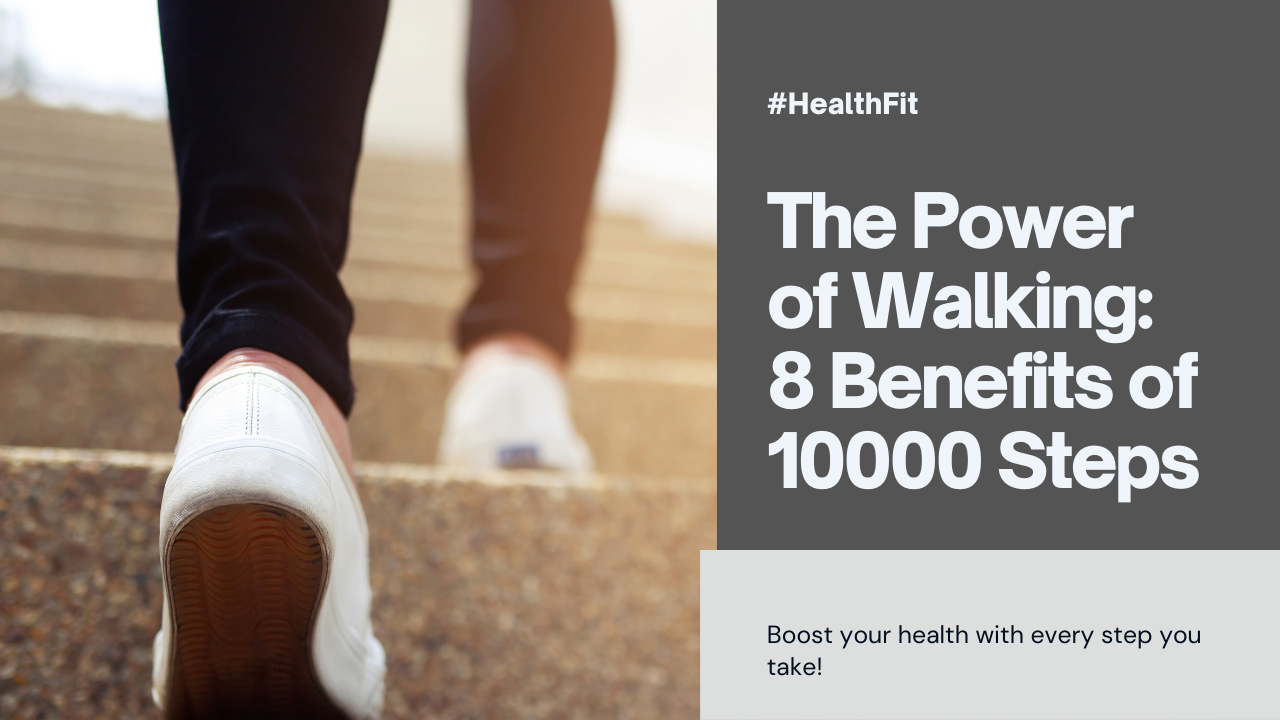Discover the numerous health benefits of walking more than 10,000 steps daily. From better heart health to improved mood and increased energy levels, find out why surpassing this step goal can enhance your overall well-being.
Benefits of walking
Walking 10,000 steps each day has become popular for staying healthy. Even though the number might seem random, research shows it brings many benefits. Here are eight reasons why walking more than 10,000 steps a day is good for you:
- Better Heart Health: Walking gets your heart working and your blood flowing, which is good for your heart. It lowers the chances of heart diseases, strokes, and high blood pressure.
- Helps with Weight: Walking burns calories, which helps you manage your weight. Doing more than 10,000 steps a day means burning more calories, which can help with losing weight or keeping it steady if you eat well.
- Boosts Mood: Walking makes your body release chemicals that make you feel happy and less stressed. Doing over 10,000 steps a day can lift your spirits and reduce anxiety.
- More Energy: Walking boosts your circulation and gives you more oxygen, making you feel more energetic. Walking a lot each day can reduce tiredness and give you a natural energy lift.
- Improves Sleep: Being active, like walking, helps you sleep better. If you do more than 10,000 steps daily, you might find yourself falling asleep easier, sleeping deeper, and waking up feeling more rested.
- Strengthens Muscles and Bones: Walking is good for your bones and muscles. It helps keep your bones strong and muscles toned. Doing more than 10,000 steps a day can improve your muscle strength and support your bones.
- Sharpens Your Brain: Walking keeps your brain healthy. Regular walking, even more than 10,000 steps daily, can make you think better and reduce the chance of memory problems as you get older.
- Longer Life: People who walk a lot tend to live longer and have fewer health problems. By walking over 10,000 steps every day, you can increase your lifespan and enjoy better health as you age.
In short, walking more than 10,000 steps each day brings many health benefits. It helps your heart, weight, mood, energy levels, sleep, muscles, brain, and can even help you live longer. So, make walking a part of your daily routine and aim to exceed that 10,000-step goal to stay healthy and happy.
How can I track my daily steps?
Keeping track of your daily steps is a great way to stay motivated and keep an eye on how active you are. Here are some easy ways to do it:
- Use Smartphone Apps:
- Apple Health: If you have an iPhone or Apple Watch, you can use the built-in Apple Health app. It automatically counts your steps throughout the day.
- Google Fit: Android users can use Google Fit, which also tracks steps, distance, and other fitness stuff.
- Get a Step Tracker:
- You can buy a step tracker device that counts your steps. Here are some popular ones:
- 3DTriSport Pedometer: Affordable and easy to use.
- Fitbit Ace Activity Tracker: Made for kids.
- OZO Fitness C3D Pedometer: Good for older folks.
- Garmin Vívoactive® 4: Perfect for serious runners.
- OURA Ring Gen 3: A cool ring tracker.
- Samsung Galaxy Watch4 and Fitbit Versa 3: Great for tracking on the go.
- StepsApp and Pacer: Apps for tracking steps on your phone.
- Keep a Written Record:
- If you like pen and paper, you can print out a walking log sheet. Stick it somewhere you’ll see it often, like the fridge or your journal. Write down your steps each day to stay on track.
Remember, tracking your steps can be fun and help you stay active. Pick the method that suits you best and enjoy getting those extra steps in! 🚶♀️🚶♂️
The best time to walk for maximum benefits
The best time to walk for maximum benefits can vary based on what works best for you. Here are some options:
- Morning: Walking in the morning can give you energy for the day and clear your mind.
- After Meals: Taking a short walk after eating can help your digestion and regulate blood sugar levels.
- During Breaks: Walking during breaks from work or other activities can reduce stiffness and improve circulation.
- Before Bed: A calm walk in the evening can help you relax and sleep better.
Choose the time that fits your schedule and feels good for you. Being consistent is what matters most!
Some specific walking techniques or postures to follow
There are some simple techniques and postures you can follow to make your walking more effective and comfortable:
- Posture:
- Stand tall with your head up, shoulders back, and abdomen slightly engaged.
- Keep your gaze forward, not downward.
- Swing your arms naturally, with a slight bend at the elbows.
- Footwork:
- Start by landing on your heel and roll through to your toe with each step.
- Keep your steps natural and not too long or too short.
- Maintain a steady pace that allows you to walk comfortably without straining.
- Stride:
- Take comfortable strides, neither too short nor too long.
- Avoid overstriding, which can strain your muscles and joints.
- Aim for a smooth, rhythmic motion with each step.
- Breathing:
- Breathe deeply and rhythmically, syncing your breath with your steps.
- Inhale through your nose and exhale through your mouth.
- Focus on maintaining a steady breathing pattern to optimize oxygen flow to your muscles.
- Core Engagement:
- Keep your core muscles lightly engaged throughout your walk to support your posture and stability.
- Avoid slouching or leaning forward excessively.
- Relaxation:
- Stay relaxed and loose in your movements, avoiding tension in your muscles.
- Relax your shoulders and let your arms swing naturally.
- Terrain Consideration:
- Pay attention to the terrain you’re walking on and adjust your stride and pace accordingly.
- When walking uphill, take shorter steps and lean slightly forward.
- When walking downhill, take shorter steps to control your descent and reduce impact on your joints.
By following these simple techniques and postures, you can make your walking more efficient, enjoyable, and beneficial for your overall health and well-being.
The recommended daily step goal
The recommended daily step goal differs for each person based on things like age, fitness level, and health goals. A common suggestion is to aim for around 10,000 steps a day. This number came from a campaign in Japan a long time ago, but now many people use it as a goal for staying active and healthy.
However, any increase in daily steps can be good for your health. If you’re not very active right now, it’s okay to start with smaller goals, like adding 500 to 1,000 steps each day.
The most important thing is to pick a step goal that’s realistic for you and your lifestyle. Listen to your body, set achievable goals, and gradually increase your activity level over time.
10 Ways to Increase Your Step Count Without Long Walks
Increasing your step count without going for long walks is possible with a bit of creativity and small changes to your daily routine. Here are some simple tips:
- Take the Stairs: Instead of using elevators or escalators, opt for the stairs whenever possible. Climbing stairs can quickly boost your step count and improve cardiovascular fitness.
- Park Farther Away: Park your car farther away from your destination to add extra steps to your journey. This minor adjustment can accumulate more steps throughout the day.
- Walk During Breaks: Take short walks during breaks at work or while watching TV at home. Set a timer to remind yourself to get up and move every hour.
- Use Active Transportation: Walk or bike for short trips instead of driving. This not only increases your step count but also reduces carbon emissions and saves money on fuel.
- Break Up Sitting Time: Stand up and stretch, march in place, or take a quick walk around the room every hour to break up prolonged sitting periods.
- Do Household Chores: Engage in household chores like vacuuming, sweeping, or gardening, which involve a lot of movement and can contribute to your step count.
- Take Phone Calls on the Move: Instead of sitting while talking on the phone, walk around the room or pace back and forth to accumulate steps.
- Dance or Move While Cooking: While cooking or doing kitchen tasks, turn on some music and dance or move around to add steps to your day.
- Set Step Goals: Challenge yourself to reach specific step goals each day and track your progress using a pedometer or a smartphone app.
- Walk in Place: If you’re watching TV or waiting for something, walk in place to keep moving and increase your step count.
By incorporating these simple strategies into your daily routine, you can boost your step count without the need for long walks and enjoy the health benefits of increased physical activity.
Join Walking Challenges and Communities for Fun and Motivation
If you want to stay motivated and connect with others who love walking, there are lots of options for you:
- Virtual Challenges: Websites and apps offer challenges where you can set goals and track your progress.
- Fitness Apps: Apps like Fitbit and Strava let you join groups and share your achievements with others.
- Local Walking Groups: Look for groups in your area through community centers or social media. They often organize walks and events.
- Charity Walks: Join charity events to support causes you care about and meet others who share your interests.
- Online Communities: Join forums or Facebook groups to connect with walkers worldwide and get tips and inspiration.
- Corporate Programs: Some workplaces offer wellness programs with walking challenges and rewards.
- Friends and Family Challenges: Create your own challenges with friends or family to stay motivated together.
- Local Events: Keep an eye out for local walks or fitness events in your community.
Joining walking challenges and communities can make walking more fun and help you reach your fitness goals!
10 Ways to Make Walking More Enjoyable and Fun!
Making walking more enjoyable can involve adding variety, finding motivation, and incorporating elements of fun into your routine. Here are some simple tips to make walking a more enjoyable activity:
- Change Your Route: Explore different walking paths, trails, parks, or neighborhoods to keep your walks interesting and discover new scenery.
- Listen to Music or Podcasts: Create a playlist of your favorite songs or listen to podcasts or audiobooks while walking to make the time fly by and keep you entertained.
- Walk with a Friend: Invite a friend, family member, or coworker to join you for a walk. Walking with a companion can make the experience more enjoyable and provide an opportunity for socializing.
- Set Goals and Challenges: Challenge yourself to reach specific goals, such as increasing your step count, walking a certain distance, or completing a walking route in less time. Setting goals can provide motivation and a sense of accomplishment.
- Focus on Mindfulness: Pay attention to your surroundings, engage your senses, and practice mindfulness while walking. Notice the sights, sounds, and sensations around you to enhance the experience.
- Take Photos: Bring a camera or use your smartphone to capture interesting sights or beautiful scenery during your walks. Photography can add an element of creativity and appreciation for your surroundings.
- Join a Walking Group or Community: Join a local walking group, fitness class, or online community of walkers to connect with others who share your interest and provide encouragement and support.
- Reward Yourself: Treat yourself to a small reward or incentive after completing a walk, such as enjoying a healthy snack, taking a relaxing bath, or indulging in your favorite activity.
- Experiment with Intervals or Challenges: Incorporate intervals of faster-paced walking or set mini challenges, such as walking to a landmark or completing a certain number of laps around a track.
- Be Prepared: Dress comfortably, wear supportive footwear, and bring along water and snacks to ensure you’re prepared and comfortable during your walks.
By incorporating these tips into your walking routine, you can make walking a more enjoyable and fulfilling activity that you look forward to each day.
conclusion
In conclusion, walking is not only an excellent form of physical activity but also a simple and enjoyable way to improve your overall well-being. By incorporating variety, motivation, and elements of fun into your walking routine, you can make it a rewarding and sustainable habit. Whether you explore new routes, listen to music, walk with friends, or set personal goals, finding what works best for you can turn walking into a source of joy and fulfillment. So, lace up your shoes, step outside, and embrace the countless benefits that walking has to offer.




